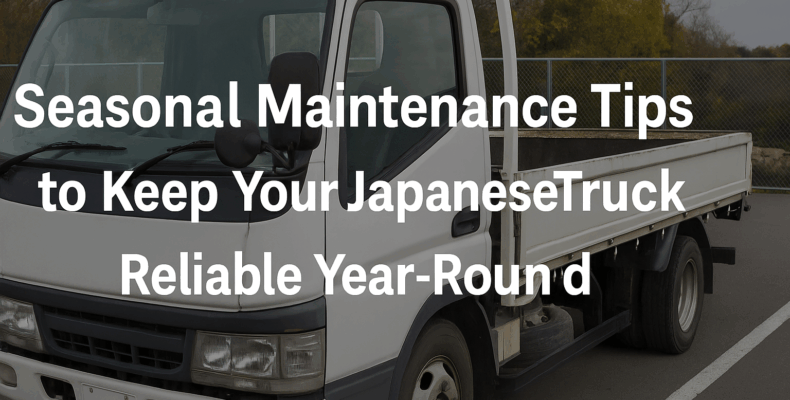Japanese used trucks are known for their strength and reliability. However, to keep them running smoothly across all climates, proper seasonal maintenance is essential. Whether you drive a Hino, Isuzu, Fuso, or Nissan Diesel, each season brings unique challenges. By preparing in advance, you can avoid costly breakdowns, improve safety, and extend your truck’s lifespan.
Let’s explore the most important seasonal truck maintenance tips for international owners of Japanese trucks.
Why Seasonal Maintenance Matters
Temperature shifts can affect your truck’s fluids, tires, and battery. Dust, snow, and heavy rain all add stress to your engine and body. Fortunately, with a clear plan, you can protect your investment.
Many overseas truck owners operate in extreme environments. From hot deserts to freezing mountain roads, seasonal care makes a major difference in performance.
Spring Maintenance Tips
After a cold winter, spring is the perfect time to inspect your Japanese truck. Focus on areas affected by moisture, ice, and salt.
Checklist:
-
Check for rust, especially on the undercarriage and brake lines
-
Inspect tires for cracks or uneven wear
-
Flush and replace coolant if it looks dirty
-
Check belts and hoses for signs of wear
-
Clean the battery terminals to remove corrosion
Spring is also a good time to check for body damage caused by winter road debris.
Summer Maintenance Tips
High temperatures can lead to overheating, especially in older trucks. That’s why summer prep is critical.
Checklist:
-
Test the air conditioning system for proper cooling
-
Check coolant levels and radiator hoses
-
Inspect the fan belt for signs of cracks
-
Use high-temperature grease on joints and suspension
-
Ensure tires are properly inflated to avoid blowouts
Heat also evaporates fluids faster. Therefore, check your engine oil, transmission oil, and brake fluid more frequently.
Fall Maintenance Tips
As temperatures begin to drop, fall is your chance to prepare for the harsh winter ahead.
Checklist:
-
Check wiper blades and replace if worn
-
Inspect lights to ensure visibility during early sunsets
-
Top up washer fluid with a winter blend
-
Check heater and defroster performance
-
Grease all chassis points before cold weather stiffens joints
Fall is also a smart time to review your truck’s battery health. Cold weather weakens older batteries.
Winter Maintenance Tips
Cold weather is tough on engines, batteries, and tires. That’s why winter maintenance is crucial.
Checklist:
-
Use winter-grade engine oil (such as 5W-30) for easier starts
-
Install snow tires or all-terrain tires for better grip
-
Keep the fuel tank above half-full to avoid moisture buildup
-
Check glow plugs or intake heaters on diesel engines
-
Warm up the engine before driving to prevent wear
In areas with snow, inspect brakes often. Salt and ice can damage pads and rotors quickly.
Seasonal Maintenance Table
| Season | Focus Areas | Recommended Actions |
|---|---|---|
| Spring | Rust, coolant, tires | Underbody wash, coolant flush, tire inspection |
| Summer | Cooling system, AC, fluids | Radiator check, AC recharge, fluid top-up |
| Fall | Visibility, battery, chassis lubrication | Light check, terminal cleaning, undercarriage greasing |
| Winter | Starting system, traction, fuel system | Battery test, snow tires, winter oil |
Maintenance Tip: Use Local Conditions to Guide Timing
In tropical regions, you may not need winter oil. In high-altitude areas, even summer nights can be freezing. Always adapt your maintenance to the climate and road conditions in your region.
Don’t Forget: Source From Trusted Exporters
Buying a quality used Japanese truck is the first step. Maintaining it properly comes next. That’s why we recommend checking this list:
👉 Top 5 Trusted Japanese Used Truck Exporters for Global Buyers
These exporters offer not only reliable trucks, but also expert advice and support for overseas buyers.
